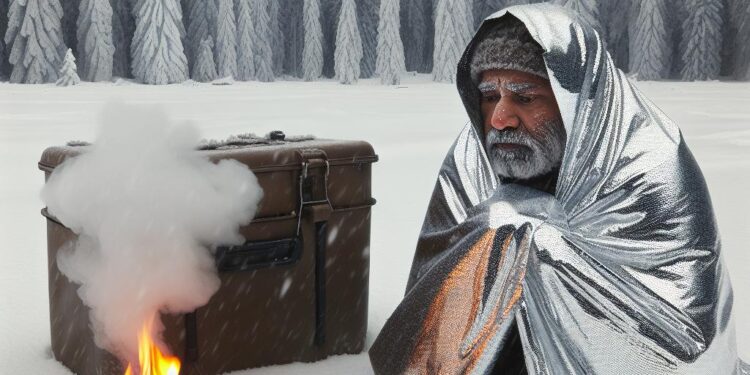Understanding how to prevent hypothermia in cold weather scenarios isn’t just for seasoned adventurers. It’s an essential survival skill for anyone venturing into the great outdoors. Knowing what to do when temperatures plummet can literally save lives, whether you’re facing a sudden storm on a camping trip or a prolonged power outage at home. Many make the mistake of underestimating the cold, forgetting to layer properly, or neglecting shelter. This blog will provide practical advice that breaks down common pitfalls and offers realistic solutions. Aligned with Survivor Daily’s mission, it ensures you’re prepared for whatever life throws your way.
How Can You Prevent Hypothermia in Cold Weather?
Preventing hypothermia in cold weather scenarios is all about keeping your body heat where it belongs—in your body. When you’re out in the wilderness or facing an emergency situation, your body’s warmth becomes your best friend. Hypothermia happens when you lose more heat than you generate, leading to dangerously low body temperatures. Imagine you’re out hiking in the Scottish Highlands and get caught in an unexpected snowfall. The key to survival? Staying dry, layering up, and maintaining a warm core temperature. This isn’t just a skill; it’s a survival must-have. Whether you’re prepping for an unexpected cold snap or living off-grid, understanding how to protect yourself against hypothermia is crucial. Picture being stranded without a base camp or central heating—knowing how to prevent hypothermia could be your ticket to ride out the cold safely. In essence, it’s about smart planning and having the right gear, akin to nature’s own insurance policy.Survival Benefits of Preventing Hypothermia
Understanding how to prevent hypothermia in cold weather scenarios is crucial for anyone venturing into the great outdoors. Here’s a list highlighting the key benefits:- Improved Survival Readiness: Knowing how to prevent hypothermia enhances your ability to survive unexpected cold conditions, increasing your chances of making it back home safely.
- Increased Personal Safety: By recognising the early signs of hypothermia, you can take proactive steps to prevent it, ensuring your safety and that of your companions.
- Optimised Gear Use: Understanding hypothermia prevention helps you choose the right clothing and equipment, ensuring you stay warm without over-packing.
- Enhanced Health in Emergencies: Quick response to cold exposure minimizes health risks, keeping your body functioning optimally in emergency situations.
- Reduced Reliance on Modern Systems: With knowledge of hypothermia prevention, you’re less dependent on external help, like rescue services, in cold environments.
- Higher Confidence in Outdoor Skills: Being prepared for cold weather boosts your confidence, allowing you to enjoy outdoor adventures without fear.
- Preservation of Energy: Effective hypothermia prevention conserves your energy, enabling you to tackle other survival challenges more efficiently.
Staying Warm: Everyday Tips from Hypothermia Prevention
– Dress in layers whenever you’re outdoors in cold weather. This simple practice helps retain body heat and keeps you insulated. It works whether you’re hiking a mountain or heading to the market.– Keep emergency survival kits in both your car and home, including essentials like high-energy food, warm blankets, and waterproof matches. Urban dwellers should consider this for travel delays or winter emergencies.
– Learn to build an improvised shelter using natural materials like branches and leaves, or an urban equivalent using available resources like cardboard. This knowledge is essential when camping or if stranded in colder urban areas.
– Invest in high-quality sleeping bags and thermal wear designed for cold climates. These items are lifesavers during outdoor adventures and unexpected power outages at home.
– Hydrate regularly, even in cold weather. A well-hydrated body maintains warmth more effectively. Integrate this into your daily routine to avoid hypothermia, whether in the city or countryside.
DIY Tips & Guidance: Preventing Hypothermia in Cold Weather
- Wear multiple layers to trap warmth effectively, keeping the cold at bay.
- Stay dry by avoiding sweating or getting wet; carry a waterproof jacket.
- Know the symptoms of hypothermia: confusion, shivering, and fatigue.
- Seek shelter from wind and rain to maintain body heat.
- If unsure about your gear or skills, consider survival courses to up your game.
- Invest in high-quality, professional gear for extreme cold conditions.
Time and Cost of Hypothermia Prevention
Understanding the costs and time involved is essential when preparing for a successful strategy to prevent hypothermia in cold scenarios.| Item/Activity | Cost | Time/Effort |
|---|---|---|
| Layered Clothing | £50 – £200 | Searching for the right fit can take a weekend |
| Insulated Sleeping Bag | £100 – £350 | Researching features might take a day |
| Survival Blanket | £5 – £25 | Minimal effort; easily found online |
| Fire-making Kit | £10 – £30 | Practice needed; an evening’s worth |
| Hypothermia Awareness and Training | Free to £100 | Weekend workshops or a day’s reading |
| Building a Shelter | No cost | Several hours for perfecting technique |




